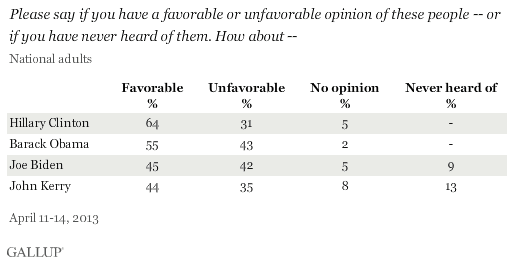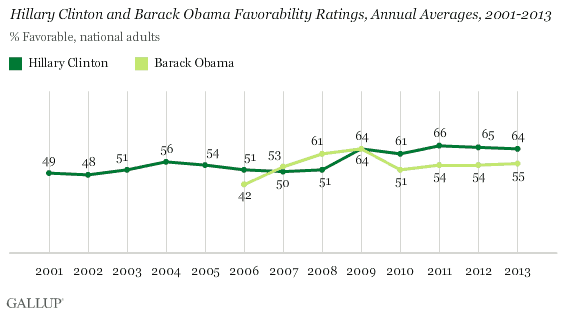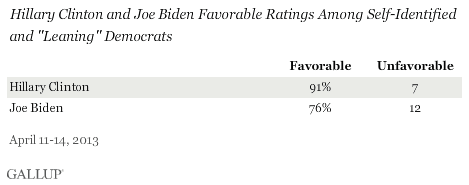WASHINGTON, D.C. -- Though currently she is -- at least temporarily -- out of political life, former U.S. Secretary of State Hillary Clinton continues to enjoy a strong favorability rating, now 64%. Americans view Clinton more favorably than the president and vice president, as well as Clinton's successor, Secretary of State John Kerry.

The April 11-14 survey predates the April 15 bombings near the finish line of the Boston Marathon that killed three people and injured more than 180. It's not clear what impact, if any, that event and the ensuing manhunt that shut down Boston and nearby communities will have on the favorability ratings of the president or any other administration figures.
President Barack Obama's approval rating climbed to 50% in Gallup Daily tracking last week -- higher than it has been since late February. His approval rating Tuesday, April 23, is 51%.
These results also precede the Senate's failure to pass a gun control bill that would have extended background checks to all commercial gun sales -- a high priority for the Obama administration, and a policy that is popular with Americans.
All four Democrats have more favorable than unfavorable ratings. But while Clinton and Obama are almost universally known, 14% of Americans didn't rate Biden and 21% didn't rate Kerry, despite the latter's high-profile 2004 campaign for the presidency that left him 19 electoral votes short of becoming the nation's top executive.
Clinton's annual average favorability rating has exceeded that of her former boss -- and one-time presidential rival, Obama -- since 2010. President Obama's current favorability rating is roughly equivalent to his 54% average favorability for 2011 and 2012, but is down from his high of 64% for 2009.

Clinton's Current Favorable Rating Could Mean She Has an Edge for 2016
Clinton and Biden are rumored to be strongly considering a run at the 2016 Democratic presidential nomination. At the moment, Clinton appears to have the upper hand in terms of overall favorability -- her rating is 19 percentage points higher than Biden's.
Clinton also has a favorability advantage over Biden among Democrats and Democratic leaners, suggesting she may have more unified support within her party's base -- which would be particularly important in a Democratic primary. Ninety-one percent of Democrats and Democratic leaners hold a favorable opinion of Clinton, while 76% think likewise of Biden. Of course, these are not mutually exclusive positions -- one can think positively of both -- but it does suggest that Clinton starts out with an advantage, at least right now, should these two face off in a 2016 primary.

Still, Clinton's favorability ratings exemplify how public opinion can shift dramatically over time and a once-controversial figure can become widely well-regarded. In 2001, when Clinton first became the junior senator from New York, her annual average favorability rating was a lackluster 49%. By 2008, the year she and Obama contested the Democratic nomination for president, her average favorable rating was a bare majority of 51%. After President Obama appointed her as secretary of state in 2009, however, her favorability improved to 64% and has remained elevated since. The downward drift in Obama's favorability ratings, no doubt, reflects the highly partisan environment in which the president operates.
Implications
At a time when many political analysts are floating Former Secretary of State Clinton's name as a potential contender for the Democratic presidential nomination, her favorability rating outshines those of current Obama administration officials, including the president himself. Vice President Biden is also reportedly considering running in 2016, but as of now, his favorability rating is not nearly as high as that of his possible competitor, among rank-and-file Democrats and among the public in general. But as the past trajectory of Clinton's favorability ratings shows, this could easily change.
Meanwhile, Secretary of State Kerry begins his time in the position with a more favorable than unfavorable rating, although one in five Americans have no opinion of him. While Clinton's tenure as secretary of state coincided with a boost in her image ratings, it is unclear whether Kerry's image will follow this same trajectory.
Survey Methods
Results for this Gallup poll are based on telephone interviews conducted April 11-14, 2013, with a random sample of 1,012 adults, aged 18 and older, living in all 50 U.S. states and the District of Columbia.
For results based on the total sample of national adults, one can say with 95% confidence that the margin of sampling error is ±4 percentage points.
Interviews are conducted with respondents on landline telephones and cellular phones, with interviews conducted in Spanish for respondents who are primarily Spanish-speaking. Each sample of national adults includes a minimum quota of 50% cellphone respondents and 50% landline respondents, with additional minimum quotas by region. Landline telephone numbers are chosen at random among listed telephone numbers. Cellphone numbers are selected using random digit dial methods. Landline respondents are chosen at random within each household on the basis of which member had the most recent birthday.
Samples are weighted to correct for unequal selection probability, nonresponse, and double coverage of landline and cell users in the two sampling frames. They are also weighted to match the national demographics of gender, age, race, Hispanic ethnicity, education, region, population density, and phone status (cellphone only/landline only/both, cellphone mostly, and having an unlisted landline number). Demographic weighting targets are based on the March 2012 Current Population Survey figures for the aged 18 and older U.S. population. Phone status targets are based on the July-December 2011 National Health Interview Survey. Population density targets are based on the 2010 census. All reported margins of sampling error include the computed design effects for weighting.
In addition to sampling error, question wording and practical difficulties in conducting surveys can introduce error or bias into the findings of public opinion polls.
View methodology, full question results, and trend data.
For more details on Gallup's polling methodology, visit www.gallup.com.
